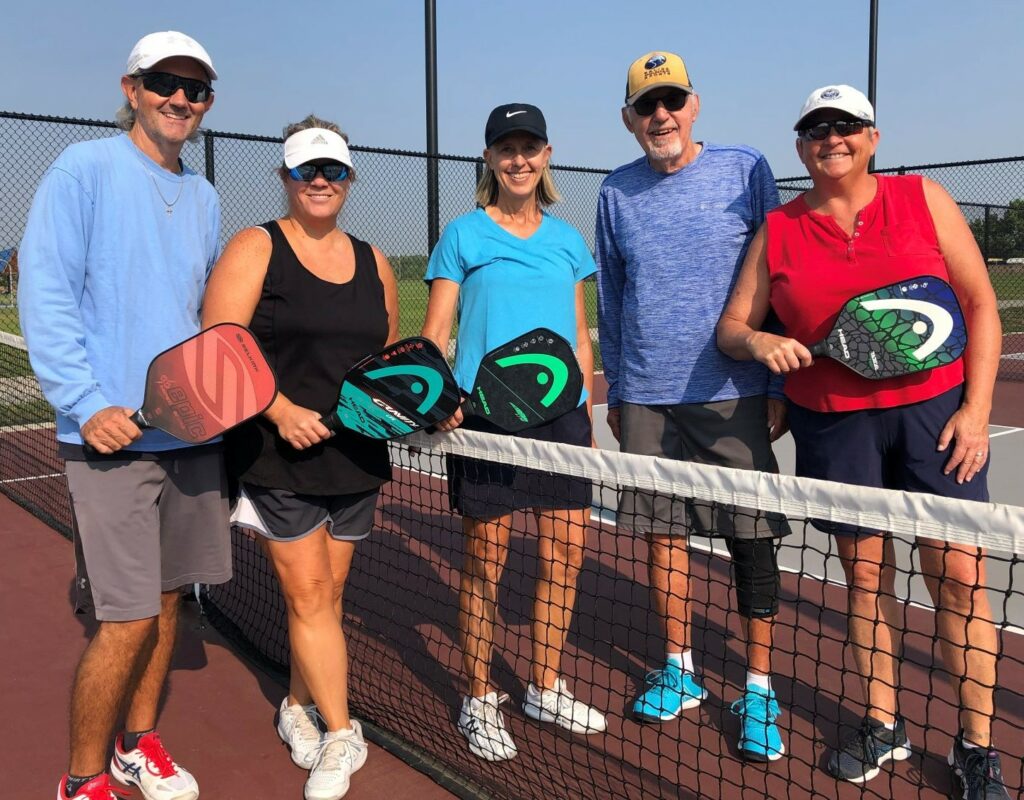
Dennis Shepherd jogged off the pickleball court to sit and rehydrate one recent summer morning. Shepherd plays every Tuesday at Clear Creek Valley Park with his daughters and a few new-found pickleball friends. A retired track, cross country, and basketball coach, Shepherd was delighted to pick up the game 10 years ago through a class at Apex Park and Recreation District in Arvada. “You can stay competitive,” he says, “It gets you moving. And it’s social.” Another player chimes in, “And it keeps him out of trouble!”
Pickleball’s popularity has steadily increased in recent decades, yet many are just now getting into it. Most of Shepherd’s court mates began playing in the last 2-3 years.
Pickleball was created in 1965 by Joel Pritchard, a congressperson in Washington State, and his friend Bill Bell, when the two returned home from a golf game to find their teenage children cranky and bored. Intent on teaching the salty adolescents a lesson in resourcefulness, the two men set out to make up a game out of odds and ends that Pritchard’s family had on hand. Like the good ole days, Pritchard proclaimed. By the following weekend a court—of sorts—was in place, some rules written, and the basics of the game established. A friend named Barney McCallum had joined the effort, with gusto. Joel’s wife Joan Pritchard gave the game its official name a few weeks later, drawing inspiration from the way a “pickle boat” crew of rowers is assembled from among whomever is left available after the starters are set.
Indeed, looking at the game for the first time, pickleball resembles a mash-up of badminton, wiffle ball, ping pong, and tennis. It’s a racket sport played with a solid surface paddle, smaller than a tennis racket, and a roughly 3” diameter hollow plastic ball with holes. The court is slightly larger than half a tennis court. The net height is just two inches shy of tennis’s, and both games can be played in singles or doubles. Pickleball’s scoring system? Complicated. For beginners, this proves more challenging to pick up than the game’s physical play.

To get a better picture, stop by the courts situated on the east side of Clear Creek Valley Park. The park sits just north of I-76, with access and parking from both Tennyson Street and Lowell Boulevard. And there’s much to see there beyond the courts: a fishing pond, walking path, volleyball courts, horseshoe pit, playgrounds for different age groups (including a small zipline), reservable picnic areas, and an outdoor amphitheater.
When Hyland Hills Park and Recreation District opened the park in 2017, they included pickleball courts in response to community input. With the game’s continued rise in popularity, the courts have been a hit. “We are as excited as the community,” reports Hyland’s Communications Director Joann Cortéz, “The courts have been wildly popular across the board.” So popular, in fact, that 4 more courts have just been funded for completion there in the fall of 2022.
Denver’s pickleball scene mirrors the national trend. By 1990, according to USA Pickleball, the sport could be found in all 50 states. In 2003, there were 150 individual courts across North America on record with “Pickleball Stuff,” a popular website at the time. Today there are over 21,000 in the U.S. alone. In 2013, pickleball became one of the National Senior Games Association’s 19 medal sports. And in 2017, a Pickleball Hall of Fame was launched, which promptly inducted the game’s founders.
People of all ages love pickleball. The small court yields a fun workout for almost anyone. Decent hand-eye coordination helps, and good balance is a must. Rec centers offer introductory classes; several courts have drop-in times when friends can teach friends; and, you can even hire a personal coach. You’ll eventually want your own racket and a few balls, but if you decide to start with a class, these will be available. Just show up in your court shoes.
For the most competitive and dedicated, you will eventually encounter pickleball’s rating system. Players are assigned a number based on their skill level (2.0 for newbies and up through 4.5+ for advanced and expert players). This system is used, for example, to sort players into appropriate brackets at a tournament.
But it’s just fine to keep the game casual. Back out at Clear Creek Valley Park, there are groups that bring music and take lengthy water breaks to catch up over conversation. And there’s a gentleman who brings his mom to the courts some evenings. She has dementia. The two have great fun together, and the son thinks the blood flow from exercise takes the edge off his mom’s symptoms. There’s a simplified version of pickleball, created by Coloradans Chris Beal and Georgi Marquisee, that reduces the scoring complexity and allows for a little more flexibility in the game play. This one is gaining in popularity too, especially within the Parkinson’s and Alzheimer’s communities.
And if you’ve heard the version of pickleball’s origin story that claims the game was named after Pickles, the Pritchard family dog, the Denver North Star is here to confirm that story’s out-of-bounds. The results of a thorough investigation were reported by Pickleball Magazine in their January 2021 story, “How Pickleball Really Got Its Name!” Pickles, the dog, came along in 1968, three years after that fateful 1965 summer when a couple of parents set out to prove their resourcefulness.
Kathryn has lived in North Denver since around the time the Mount Carmel High School building was razed and its lot at 3600 Zuni became Anna Marie Sandoval Elementary. She’s raised two children in the neighborhood, worked at several nonprofits, and volunteered with the Alzheimer’s Association Colorado Chapter.Do you have story ideas for The Gray Zone? Email Kathryn@DenverNorthStar.com

Be the first to comment